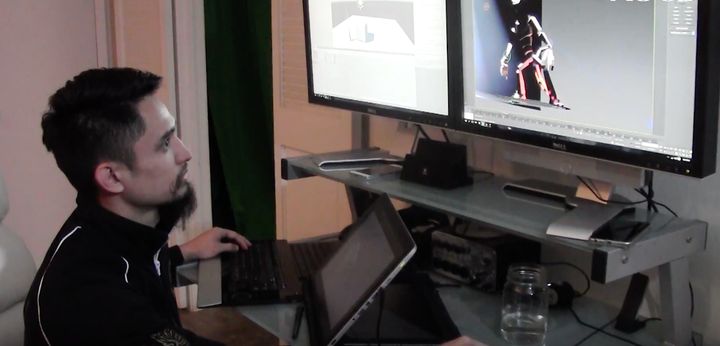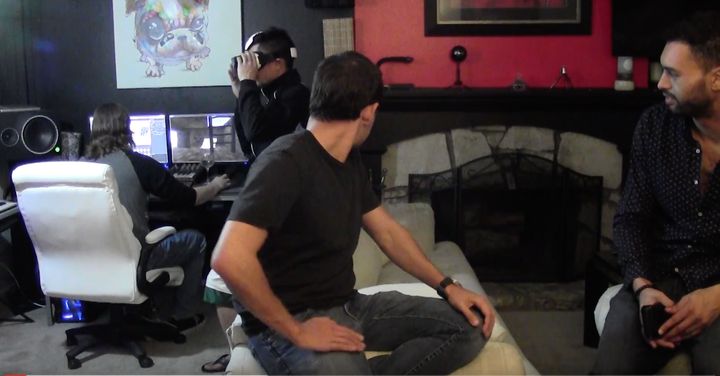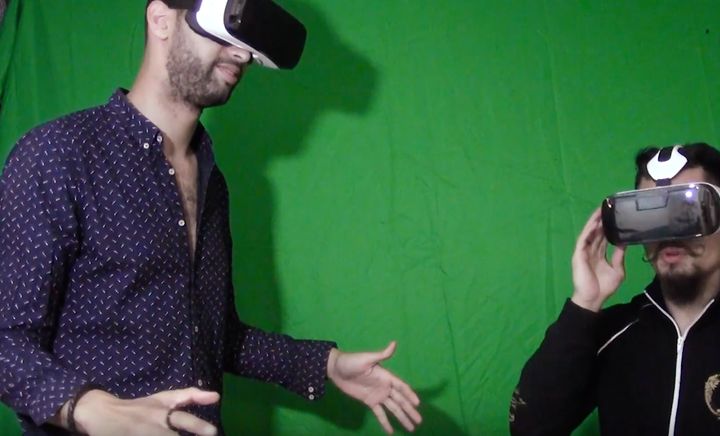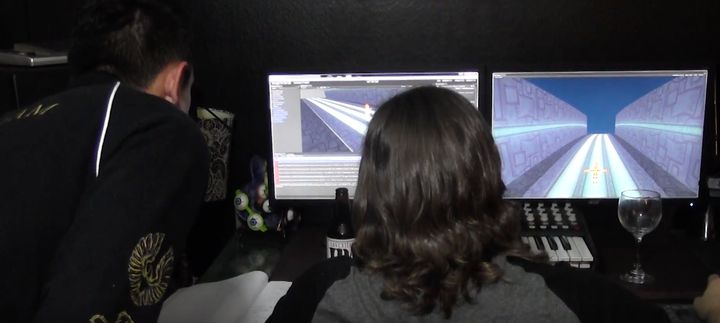Ten millennial aged men gathered in a cozy two-story home in San Diego, California. But not for the sake of hanging out. Some were parked at work stations. One modeled 3D characters on his computer. Another navigated around a 3D world he was creating for a video game. Another scrolled through a marketing video he produced.
Sometimes the guys strayed from their projects and congregated in the living room, entertained by virtual reality headsets and the basketball game on TV. They shuffled past a giant green screen in the hallway adjacent to the kitchen.
Among them was Chris Hayward, a 32-year-old 3D artist and veteran of the visual effects and gaming industries. It’s where he landed after three lay-offs in six years: at a home-based studio where around 10 digital media professionals at a time work on their own entrepreneurial and freelance endeavors. They contract each other on projects — whether a video game, mobile app, video, or website.

Chris Hayward works on an animation at a home-based studio in San Diego, CA
“I'm not a one-man company. I'm everyone,” said Hayward, who creates CGI in movies and imagery in video games. “We have a person for every piece of the pie. Whether it's someone who needs sound engineering or coding or viz (visualization).”
Hayward’s autonomous yet collaborative working arrangement has been made possible by powerful and free technology that was once very expensive and accessible only to large companies.
The technology at the core of his work is called a game engine, software used to build 3D worlds in which you can interact as a player, like what you see in video games and increasingly nowadays, in virtual reality.
The biggest engine makers have released powerful pro-level versions of their software for free. After the Unity Engine began giving out its full-featured product without too steep a learning curve, other companies followed suit. Unreal Engine went free in March 2015. Amazon released a free game engine in February 2016, called Lumberyard. CryEngine jumped on the bandwagon one month later.
“After Unity started attracting large numbers of veterans in the industry of all areas of expertise — artists, designers, programmers — that had struck out on their own after being laid off from big publishers, other engine makers were pretty much forced to follow suit,” said Marcos Sanchez, Unity’s head of global communications.
The business logic for the engine makers is that people will build products that generate revenue. Then they may owe royalties or have to purchase a pro version that includes some additional features.

Digital media entrepreneurs collaborate out of their home-based studio
That’s what game designer Erin Reynolds did after building her game “Never Mind,” a psychological thriller, using a free engine. It started gaining traction, so she crowdfunded $75,000 and hired a team to help build out a full-fledged product. Reynolds upgraded to a pro-level engine after establishing her own indie studio, called Flying Mollusk. “Never Mind” is their flagship product. Now they’re focused on adapting it for Oculus Rift, so it can be experienced in virtual reality.
The engines have fueled a boom in entrepreneurship in interactive media — virtual and augmented reality being the new great frontier. Investors have poured $8.83 billion into virtual reality endeavors since 2012, according to market research firm SuperData.
Bryan Jaycox, a game design professor at Woodbury University in Burbank, California, says that many of his friends previously working in gaming have transitioned to startups in virtual reality. “If you can be one of the first to the game, making your name in virtual reality, as a virtual reality experience designer, you’re going to do very well in this world,” Jaycox said.
That’s what Hayward is trying to do. A virtual reality application he’s working on would allow users to interior decorate their home in VR instead of having to guess how a piece of furniture might look before purchasing it.
“We have a huge opportunity now to be a leader in this new VR stuff because everyone is learning,” Hayward said. “I would rather be like the Minecraft guy who worked on his own passion thing and was able to profit off that.” He’s referring to video game programmer Markus Persson, the ultimate indie success story. Persson became a billionaire off sales of a game he developed, Minecraft.

Harrison Schaen (left) and Hayward try out a virtual reality experience
Artists like Hayward have left behind an insecure job market to focus on their own endeavors. “Every year, you're almost scared. When am I going to get laid off?” he said.
3D artists are often hired at the start of a project and fired at the end of its development cycle. They also compete with cheaper labor overseas as companies outsource work to cut down on labor costs.
That’s so companies can maximize profits, says Tom Sito, chair of the Animation and Digital Arts Division at the University of Southern California. “You want the latest technology, so you can’t save any money on that,” he said. “And you don’t want to save money on your own salary. So, what’s left? The employees.”
In one notorious 2013 case, 238 people lost their jobs after Rhythm 'N Hues Studios filed for Chapter 11 bankruptcy, 11 days after winning the Best Visual Effects Oscar for “Life of Pi.” Later that year, Disney made when headlines when it suddenly shut down the video game studio it had acquired, LucasArts, laying off 150 people.
Things haven’t changed all that much, Sito says. “It was like artists in the Renaissance. You get hired by the pope to decorate a wall. You’re not employed year-round. It’s until you finish the ceiling and you leave.”

Hayward and John Ashcroft (right) collaborate on a video game they’re making using the Unity engine
But things have changed with powerful technology now in the hands of many. It’s minted more inventive entrepreneurs, small independent studios, and giants like Markus Persson. But Persson is an anomaly.
Many may be able to identify more with Bill Graner’s experience as an independent game designer. “First we wanted to make games and sell them and make a living, which it turns out is not sustainable,” Graner said. For the last five years, he and his Crater House studio team, based out of a coworking space in San Francisco, have gotten by doing contract work for various clients.
However, they were recently paid a lump sum that will allow them to focus on their individual passion projects for the next nine months, “like an artist collective where we're each doing our own thing and helping each other out,” Graner said.
It’s like the model Hayward and his colleagues have adopted. “I feel like as artists, we are taking our power back,” Hayward said, as he and the boys dream up applications for virtual reality out of their home-based studio. “I learned all the skills necessary when I was in the industry. I've taken all those skills and I’m bringing them back home now. And making a name for myself.”
